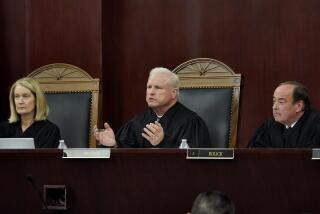How States’ Rights Can Rectify the Wrongs of the Supreme Court : Abortion: With Roe vs. Wade facing reversal, feminists may have to resort to 50 constitutions to preserve it. The justices told them how.
- Share via
WASHINGTON — Abortion-rights supporters have seen the future at the Supreme Court--and it is grim. In deciding Rust vs. Sullivan, the justices, by 5-4, forbid federally funded family-planning clinics from giving out information about abortion. A subsequent court ruling, issued without comment, upheld the Reagan Administration policy of denying foreign aid to private groups who advocate abortion.
The court’s right wing, with new justice David H. Souter providing the pivotal fifth vote in Rust, appears to have the five votes necessary to scuttle Roe vs. Wade. But the man Souter replaced, William J. Brennan Jr., did not leave pro-choice forces empty-handed. In a series of articles and legal opinions not widely publicized, he left clear instructions for the use of a little-known legal tool for preserving civil rights, including the right to abortion, on a state-by-state basis.
The Brennan theory is the modern-day version of states’ rights. But states’ rights is no longer the historic euphemism for repressing women and minorities and others excluded from a white, male segregationist society. Instead, it stands for the enhanced legal position of those who, for years, have been on the outside looking in.
“State constitutions . . . are a font of individual liberties, their protections often extending beyond those required by the Supreme Court’s interpretation of federal law,” Brennan wrote in 1977. “The legal revolution which has brought federal law to the fore must not be allowed to inhibit the independent protective force of state law--for without it, the full realization of our liberties cannot be guaranteed,” he wrote in a Harvard Law Review article.
Stanley Mosk of the California Supreme Court, a state constitutional scholar, has also said that state courts should not “change as the tides ebb and flow on the Potomac,” but should instead develop their own legal theories based on their own constitutions and look to the U.S. Supreme Court only to provide the legal base line for constitutional law.
Despite these recommendations from leading judicial liberals, most civil libertarians have stuck to the federal courts and the federal Constitution, reluctant to give up on a national system of civil rights. Only a handful have begun to reconsider. More should do so.
Because of the way the federal system works, an abortion right guaranteed by a state constitution can be made immune from high-court review. Court conservatives have signaled that they won’t tamper if state courts decide to give greater protection to civil rights.
In two key rulings of the 1980s, the justices even told the state courts how to do it.
State constitutions and state high-court judges were given new support from now-Chief Justice William H. Rehnquist. In PruneYard Shopping Center vs. Robins, a case from California, the court upheld Robins’ right to collect signatures in a privately owned shopping center for a petition protesting the U.N. anti-Zionism resolution. In the 1980 unanimous ruling, then-Associate Justice Rehnquist argued that while the U.S. Constitution did not really address the question of free-speech rights on private property, nothing prevented the state courts from looking at their own constitutions to find such a right. Rehnquist said the U.S. Constitution provided the base line for civil rights; states could not go below it but they could go above it, finding greater civil rights.
Three years later, Justice Sandra Day O’Connor spelled out how the state courts must frame their rulings. Although the high court, in Michigan vs. Long, overturned a Michigan Supreme Court ruling that had invalidated a car search that turned up marijuana, O’Connor, writing for the majority, argued that the state court could decide a case differently from the U.S. Supreme Court and then insulate the decision from high-court review. The state court had to explicitly show that its ruling was based on “adequate and independent” state law grounds and did not rely on federal law.
At least 32 state high courts already have taken the high court up on its offer. In the last 10 years, they have found that their state constitutions contain greater civil rights than are in the U.S. Constitution. The state courts have ruled on a range of issues, from the rights of criminal defendants to the right to privacy in places as diverse as the bedroom and the garbage can on the curb.
Equal-rights amendments and equal-protection guarantees also have been used by state courts to protect rights for women, minorities and even men that the U.S. Supreme Court has not guaranteed. Many state courts allow free speech on private property, such as California did in the PruneYard case; the U.S. Supreme Court said they didn’t have to under the First Amendment.
Nothing prevents state courts from offering broader protections as long as they ground their rulings exclusively in their state constitutions, and don’t offer fewer rights than are in the federal Constitution. The state constitutional route is not an option for lower federal courts, whose job is to examine federal rights, and whose work is strictly bound by limits imposed by U.S. Supreme Court rulings.
Even when the state and federal constitutions are worded identically, state court justices have managed to interpret their constitutions more generously without getting reversed at the U.S. Supreme Court. Often that is because state constitutional conventions had a different history from the federal convention.
In the abortion debate, the new states’ rights already has shown its potential. Shortly after the U.S. Supreme Court upheld the Hyde Amendment in 1980, ruling that lawmakers can deny poor women publicly financed abortions, courts in California, Connecticut, Massachusetts, New Jersey and Vermont held that their state constitutions, for a variety of reasons, required public financing of abortion for poor women. The Florida Supreme Court, in October, 1989, said that the state’s constitutional guarantee of privacy, added in a 1980 referendum, protected a teen-ager’s right to an abortion without her parents’ consent.
At least 19 states--as politically and demographically different as Louisiana, Montana, New Jersey and Texas--bar gender discrimination, either through equal-rights amendments or because state courts interpret equal-protection provisions to ban discrimination based on sex. In states without such constitutional provisions, abortion-rights activists might try to amend their state constitutions to add privacy provisions or equal-protection clauses.
A few key victories on abortion in state courts will not be lost on the U.S. Supreme Court, which often pays attention to the mood in the states. Such victories could stop any attempt to make abortion a federal crime. The workload may be daunting to abortion-rights activists, and strain their pocketbooks. Going state-by-state in court battles and referendum fights is costly. But the potential for securing the abortion right on the state level is a very real prospect. And there is ample evidence and case law to suggest that the U.S. Supreme Court would not touch those rulings once they established the state right to abortion.
While this may dismay anti-abortion advocates, it should please one of their chief supporters. Ronald Reagan opposed abortion, but he also pushed for the New Federalism, insisting throughout his presidency that returning power to the states was a noble and important aim. Abortion-rights supporters now have a chance to help him fulfill that goal.
More to Read
Get the L.A. Times Politics newsletter
Deeply reported insights into legislation, politics and policy from Sacramento, Washington and beyond. In your inbox twice per week.
You may occasionally receive promotional content from the Los Angeles Times.









